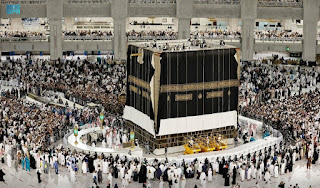nieuw jaar
Thousands of worshippers watch as the old Kiswa is replaced with a new one on the eve of the Muslim New Year 1444 early Saturday. (SPA)
Ook bepaalt volgens de Koran deze Kaäba de gebedsrichting, in de richting van Mekka en vindt je in openbare plaatsen altijd een afbeelding van de kubus (op het plafond).
De Kaäba lijkt qua uiterlijk sterk op een kubus: een rechthoekig gebouw met zijden van 12 bij 10 meter grondoppervlak en het is ongeveer 15 meter hoog. Het wordt bekleed door de 'kiswah'.
Het dekkleed zelf is een enorm zwartfluwelen doek, met zware gouddraden gestikte kalligrafische teksten uit de Koran ingeweven. Oorspronkelijk werd de kiswah vervaardigd in Egypte, maar tegenwoordig in Saoedi-Arabië.
....Describing the process, the SPA reported: "The new kiswa consisted of four separate sides and the door curtain was installed. Each of the four sides of the Kaaba was raised separately to the top of the Kaaba in preparation for its unfolding on the old side, and fixing the side from above by tying it down and dropping the other end of the side, after the ropes of the old side were loosened.
"By moving the new side up and down in a permanent movement, then the old side fell from below and the new side remained, and the process was repeated four times for each side until the dress was completed, then the belt was weighed in a straight line to the four sides by stitching it.
"This process began first from the side of the hem, due to the presence of the gutter that has its own hole at the top of the garment, and after all sides were fixed, the corners were fixed by sewing them from the top of the garment to the bottom."
Technicians at the King Abdulaziz Complex do the weaving, stitching and printing by hand and machines using 47 pieces of cloth and thread to make the Kiswa. The world’s largest computerized sewing machine, at 16 meters in length, carries out the process.
The cloth is stitched together in five different parts and fixed to the base with copper rings. Around 670 kilograms of raw silk is dyed black at the complex.
The Kiswa is decorated with Quranic verses embroidered onto the cloth with 120 kilograms of 21-karat gold thread and 100 kilograms of silver thread.
The cost of making a new 850-kilogram Kiswa is estimated to cost SR25 million, or over $6.5 million, making it the world’s most expensive covering.



Comments